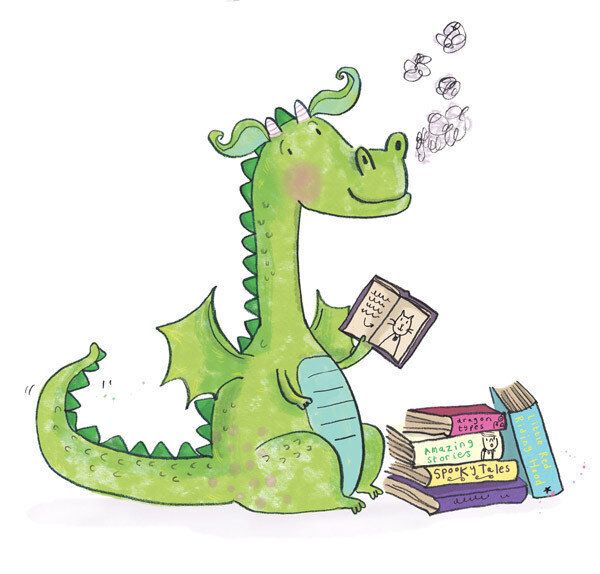After a busy World Book Day season earlier this year with as creatives I've been thinking a lot about drawing, and how powerful it can be in shaping ideas and learning. (We've worked with 12 schools from Merseyside and as far away as the North Cumbria to make illustrated books in celebration of World Book Day.)
Over the last few months I've seen some amazing ideas for stories developed by children from Year one to Year 10. The most important tool in stimulating those ideas has been drawing...
A giant monster with a manic grin looms across the page at a very shocked and, in comparison to the monster, tiny person. We discuss what the monster is called, where he lives and most importantly what is about to happen next (the monster runs off in fear when the human chases him) - a story is constructed from one emotive sketch.
A child draws a sequence showing a small doughnut bursting from a box, gradually over the space of four vignettes getting bigger and bigger, eventually morphing in to a giant doughnut monster. We are able to use the images to draw out language and descriptions to paint an even more colourful picture of what is happening.
Gathered round a large sheet of paper a class respond to drawing challenges and prompts to illustrate the building blocks of a poem about strange imaginary worlds. An image shows a girl bouncing on her bed - the moment is captured in a sketch when she is sucked through a whirlwind of stars in to the bed and strange new world. An unfortunate boy tumbles down a murky drain only to be captured by the Queen of Toilets, (a woman determined to clean up toilets across the land). Images of upside down lands, super powered trumps and penguins in toll booths emerge, all of this provides the stimulus to write an evocative sensory poem about what we would be able to see and feel if we stepped inside the picture.
The class teacher comments that starting with drawings to prompt thinking around story structure and imaginative writing was something she hadn't tried previously, and now would do after seeing the results. Drawing and literacy go hand in hand, we are all familiar with illustrated books, but it doesn't stop there. Drawing has the power to increase understanding, enjoyment and engagement across the curriculum.
Last year I attended Creating the Future, a conference organised by Cape UK exploring the impact of the arts on children's lives and learning. Eileen Adams, consultant for the Campaign for Drawing spoke of the Campaigns work with schools to use drawing as a tool for learning across the curriculum. One of the most important messages of the seminar was the importance of valuing all kinds of drawing that children do, whether it is an amazing finished piece, or a small doodle on some scrap paper and to actively include drawing and visual thinking in all subject areas.
Eileen discussed the different messages different types of drawing can convey across the curriculum. These types included scientific, diagrammatic, action and emotional. There are also countless drawing conventions that can be taught and promoted for example, sequences of images to show growth or change for science, a cross section of King Henry's stomach after a Tudor banquet for history or a thought bubble showing emotions in PSHE.

Actively tuning in to and valuing children's ability to share their thinking visually is an excellent way to increase understanding, promote discussion and inspire imaginative thinking across the curriculum. Lots of teachers know this but lack the confidence in their own drawing skills to use it as a tool for learning. Ofsted published 'Making a Mark: art, craft and design education' earlier this year, the report makes specific reference to the importance of drawing in children's educational experience:
"Children see before they speak, make marks before they write, build before they walk. But their ability to appreciate and interpret what they observe, communicate what they think and feel, or make what they imagine and invent, is influenced by the quality of their art, craft and design education."
As an illustrator I realise I have fewer hang ups about drawing than most adults do, ask me to sing in public or do long multiplication and I'll make a hasty exit, probably after breaking into a cold sweat. Many adults and teachers I work with have a similar reaction to this about drawing. When you talk to people about the root of their inhibitions it's often linked to a fear that their own skills lack refinement. They feel the wobbly sketch they have drawn is destined for the waste paper bin. Somewhere along the way the joy and enjoyment of mark making has been lost and a set of values about what is a 'good' drawing has taken a restricting hold.
'Making a Mark' highlights the importance of confidence, for both teachers and pupils, with using the medium of drawing effectively. Making a Mark recommends schools use a range of approaches the teach "adventurous drawing for all".

This sounds great - but what do Ofsted mean by adventurous drawing exactly, and how can teachers feel confident promote this ethos? In my view adventurous drawing shouldn't be about the most polished piece of work you've ever seen, it's about playing, doodling, sketching and scribbling, about understanding drawing conventions and techniques and using them to tell the story of the world around you in a playful, surprising way. Don't worry if your giraffe looks like a cow - have fun with it!
Kate is a Children's Illustrator and Director of as creatives - a multi-arts and creativity organisation based in the North West www.as-creatives.com